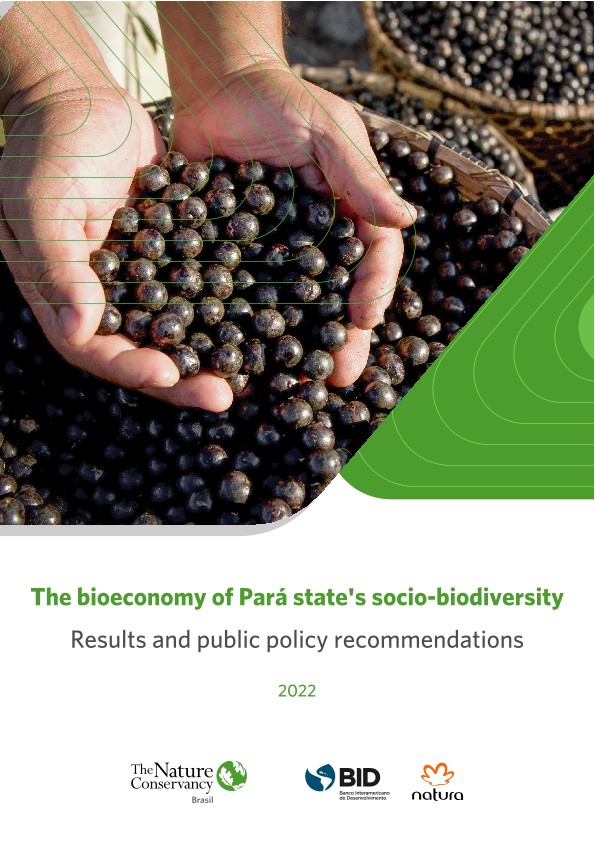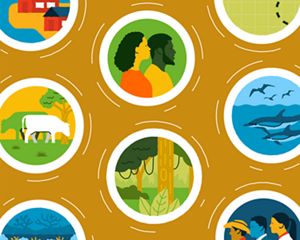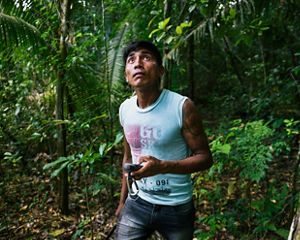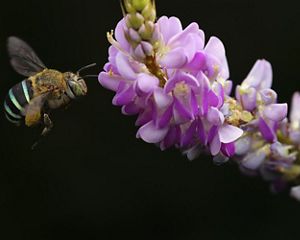The Role of Socio-bioeconomy in the Climate Agenda
The Pará State Bioeconomy Plan, created with support from TNC Brazil, was launched at COP27.
Promoting sustainable development while keeping forests standing and restoring deforested areas is crucial to transitioning to a low-carbon economy and tackling climate change. It is also an opportunity to boost a new, more inclusive, and just development model of sharing benefits, especially concerning Indigenous Peoples and traditional communities with a vast and millenary knowledge of biodiversity.
Brazil, home to the largest part of the Amazon Forest (58%), can play a central role in this agenda. The Amazon represents more than half of the planet's remaining tropical forests and houses the most tropical-forest biodiversity in the world. It is one of the six great Brazilian biomes and is home to almost 40,000 species of plants.
One of the ways to advance that model is by promoting sustainable production chains based on forests and socio-biodiversity. To increase the visibility of socio-biodiversity chains in public policies, The Nature Conservancy (TNC) Brazil, in partnership with the Interamerican Development Bank (IDB) and Natura, led the study The Bioeconomy of Socio-biodiversity, which analyzed for the first time the economic potential of the socio-biodiversity chains in Pará.
The study, launched last year and coordinated by Professor Francisco de Assis Costa, Ph.D., from the Center for High Amazonian Studies (NAEA/UFPA), demonstrated that ten of 30 socio-biodiversity products alone generated revenues of $1 billion in 2019 and can generate approximately $30 billion yearly with investments in structuring production, local value-added, and access to international markets. Another study highlight was calculating the number of people who work in the socio-biodiversity chains, totaling 224,000.
Pará State Bioeconomy Plan
One year following the study's publication, socio-biodiversity's bioeconomy continues to grow in Pará. With 70% of the state covered by preserved forests and more than half of them in the hands of Indigenous Peoples, Quilombolas, and riparian and extractive communities who move that economy, Pará was a pioneer in shaping a socio-bioeconomic strategy for the Amazon focusing on biodiversity and forests. On Wednesday, November 16, the state launched its Bioeconomy Plan (Planbio) at COP27.
During the launch, Helder Barbalho, Pará's governor, thanked Indigenous Peoples for contributing to Planbio's development and said that the Plan is the result of a challenge and was created based on three pillars: research, development, and innovation; cultural and genetic heritage; and production chains and sustainable businesses.
"In the last few years, Pará was the state that emitted the largest amount of CO2 in the Brazilian territory, and that challenged us to find a solution that would allow a transition and better use of the soil in a state with enormous territorial expanse. Planbio is part of the Amazon Now Plan, which has actions that solidify Pará's socio-economic and environmental transformation with monitoring, inspections, control, and land-use assessment."
José Otavio Passos, TNC Brazil's Amazon Director, was at the event and highlighted the importance of the Plan and how it can transform Pará state and the Amazon. "It's a robust and modern Plan created collectively in collaboration with various sectors, and now the challenge is implementing it. In a state where more than 60% of forests are protected and cared for by traditional Peoples, the Plan hits the socio-bioeconomy target. In addition, it's also important to consider socio-bioeconomy as food security since it is also an adaptation Plan in a climate-change scenario."
Created with support from TNC Brazil, the GCF Task Force, and the UNDP, Planbio was developed in a participatory way and discussed with 41 organizations and more than 300 people, including representatives from the public and private sectors, universities, NGOs, Indigenous Peoples, Quilombolas, and traditional communities. It features an analysis of Pará's socio-bioeconomy, guidelines, and actions involving all state agencies.
Quote: Juliana Simões
The actions foreseen in Planbio consider filling data gaps in the state's bioeconomy sector and stimulating production and sustainable forest businesses.
Juliana Simões, Deputy Manager of the Indigenous Peoples and Traditional Communities Strategy at TNC Brazil, followed the Plan's development. According to her, it is important to have a Plan because it provides a way to coordinate government actions and mobilize budgets to implement the state's bioeconomy strategy.
"The actions foreseen in the Planbio consider filling data gaps on the bioeconomy sector in the state and stimulating production and sustainable forest businesses, promoting specialized technical assistance, valuing the knowledge and culture of Indigenous Peoples and traditional communities, in addition to contributing to innovation and the verticalization of socio-biodiversity production chains, adding technology, value, and improving rural income. "
It is worth noting that Pará's bioeconomy vision goes beyond sustainable production and foments jobs, income generation, and nature-based solutions (NbS), ensuring the security of genetic heritage and valuing the knowledge of traditional Peoples, with social inclusion and a just sharing of benefits.
Download
Access the document with a summary of results and public policy recommendations.
DOWNLOADGlobal Insights
Check out our latest thinking and real-world solutions to some of the most complex challenges facing people and the planet today.




